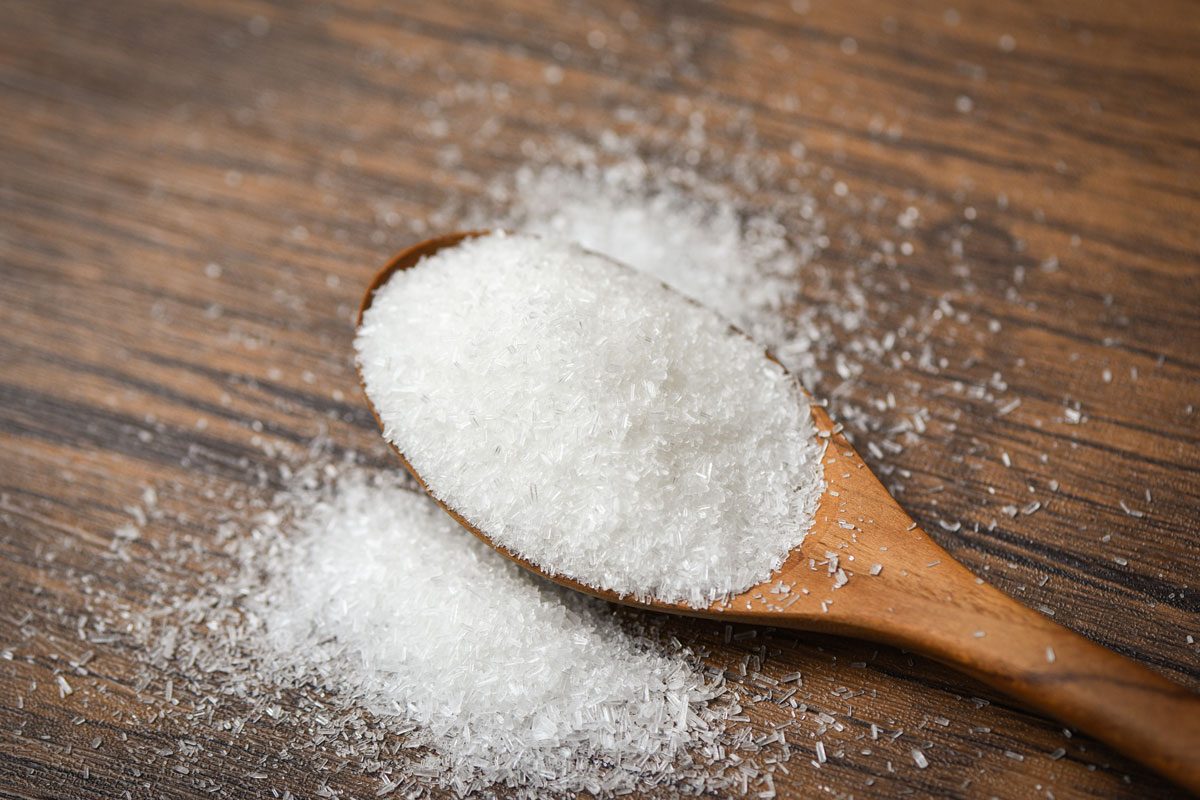Many people avoid MSG, afraid it could cause migraines and muscle aches, but how bad is it really? And how does it compare to salt?
Our editors and experts handpick every product we feature. We may earn a commission from your purchases.


Many people avoid MSG, afraid it could cause migraines and muscle aches, but how bad is it really? And how does it compare to salt?
Our editors and experts handpick every product we feature. We may earn a commission from your purchases.
About the experts
|
Highlights
|
Monosodium glutamate, or MSG, is one of the most widely used food additives in the world. “Thanks to its unique composition, it can be used in a variety of dishes to add that delicious ‘umami’ flavor profile,” says Bridgette de Juan, RDN, LDN, a registered dietician with Orlando Health.
But MSG isn’t just a flavor enhancer added to processed items. It’s a naturally occurring compound found in many foods, de Juan explains, from fresh fish to fruits and vegetables. Even so, there’s been decades of debate over its safety. Due to this stigma, you may come across restaurants advertising MSG-free menus—particularly those of Asian cuisine, which often contains MSG.
Many MSG health risks have been debunked, but research on its potential health effects is still mixed. For instance, a small number of people may be more sensitive to MSG and experience a reaction, especially when consuming it in high amounts, explains Katy Willbur, MS, RD, LDN, a clinical dietitian at the Frances Stern Nutrition Center at Tufts Medical Center.
Below, experts explain what you should know about MSG and if it’s really that bad for you.
MSG is a flavor enhancer commonly added to Chinese food, canned vegetables, soups, and processed meats. It is part of a larger group of chemicals called glutamates. “MSG contains glutamic acid, which is also naturally found in tomatoes, parmesan cheese, meat, walnuts, clams, sardines, mushrooms, and other foods,” says Emily Rubin, RD, LDN, MPH, the director of clinical dietetics at Thomas Jefferson University in Philadelphia.
In a nutshell, MSG is produced by fermenting starch, sugar beets, sugar cane, or molasses. Fermentation is the process by which yeast or bacteria convert carbs into alcohol. This is the same process used to make yogurt and other healthy fermented foods.

MSG is added to foods to enhance their savory or umami quality. Umami is a fifth flavor category, joining sweet, sour, salty, and bitter, according to the Academy of Nutrition and Dietetics.
MSG has no texture or smell. It simply enhances a food’s natural flavor as opposed to adding a new one and tends to be most flavor-intensifying when used in poultry, seafood, meats, and some vegetables. So, if you want to avoid MSG, you’ll always want to check out the ingredient list on the labels of prepared foods.
MSG is naturally abundant in a variety of foods, de Juan says, including mushrooms, cheeses, tomatoes, potatoes, seaweed, soy sauce, yeast extract, and human milk. Typically, any food associated with an “umami” flavor will contain some level of MSG, including meats and fish—but even foods like apples, carrots, onions, and walnuts are natural sources.
MSG is also commonly used as a flavor enhancer, Willbur says—and it’s one of the most popular additives in the world, according to 2023 research published in Heliyon. You’ll find it in manufactured, processed foods, including processed meats, crackers, frozen meals, soups, salad dressings, canned tuna, fast food, crackers, potato chips, and more.
“It is important to note that there is not a difference in the chemical structure of naturally derived MSG or the additive for monosodium glutamate,” de Juan explains. That means the MSG found naturally in foods like mushrooms is the same as the MSG added to processed foods.
Another thing to know: if MSG is found naturally in some of the ingredients (hydrolyzed vegetable protein, autolyzed yeast, hydrolyzed yeast, yeast extract, soy extracts, and protein isolate), the manufacturer does not have to list MSG on the label. That said, these foods can’t say “No MSG” or “No added MSG” on their packaging.
MSG also cannot be listed as a generic spice or flavoring. The U.S. Food and Drug Administration (FDA) requires foods containing added MSG to list it on the ingredient panel as monosodium glutamate.
MSG is not inherently bad for you, according to experts. The FDA lists MSG as “generally recognized as safe” (GRAS)—and global health groups, including the United Nations Food and Agriculture Organization (FAO) and the World Health Organization (WHO) agree.
“Just because a food has MSG listed as an ingredient does not mean we should be quick to determine if it is unhealthy,” de Juan says. For instance, many fruits and vegetables naturally contain MSG.
The “unhealthiness” of certain foods with added MSG doesn’t necessarily have to do with MSG itself. “The culprit often points towards the overall nutrient composition of ultra-processed foods,” she says. Prepackaged foods like soups, chips, crackers, condiments, soy sauce, and processed meats like salami, pepperoni, or canned meats have MSG but are also loaded with salt, fats, oils, and sauces, she explains.
“Over-indulging in these salty, calorically dense foods may be the culprit as to why some people experience unpleasant ‘side effects’ but blame MSG,” de Juan says. “Surpassing our daily sodium budget for the day can lead to an unpleasant increase in blood pressure, bloating, and headaches.”
In 1968, a brouhaha ignited when a biomedical researcher wrote to the editors of the New England Journal of Medicine, citing a strange illness he developed after eating at Chinese restaurants—specifically those that cooked with MSG. His symptoms included numbness, weakness, and heart palpitations and became known as “Chinese Food syndrome.” Despite the lack of social media at the time, the letter went viral. Soon after its publication, everyone turned on MSG, and a flurry of research on its health effects began.
There has been controversy as to whether some people develop symptoms such as headaches, muscle aches, and tingling after consumption of MSG, according to Rubin. “There has been no definitive evidence of a link between MSG and these symptoms,” she says.
Despite this, some 50 years after the syndrome was first named, many U.S. consumers still say they avoid MSG, according to the International Food Information Council, an industry-funded group.

Most research suggests you’d have to eat more than 3 grams of added MSG in a sitting to experience adverse effects. A 2024 study published in the Journal of Asthma and Allergy reported that allergic reaction-style symptoms have been observed in patients in a clinical setting—but the researchers consider it likely these symptoms were due to a concentrated 3-gram dose of MSG.
The FDA explains that a typical serving of food with added MSG contains less than 0.5 grams of MSG and that Americans consume about that much daily, on average. “MSG is generally found in processed foods. If your diet is filled with fresh, whole foods, your MSG intake is low,” says Rubin.
MSG has also been linked to headaches—including a debilitating migraine headache—but this link is far from conclusive. A 2024 review of research published in Current Pain and Headache Reports explains that many studies suggest MSG does not increase the risk of headache. Others report conflicting results, however, but administer doses significantly higher than the average consumption, per the research.
Still, headaches and other symptoms might be caused by other content in MSG-containing foods, as de Juan explained. For instance, 2024 research from Scientific Reports explains that processed meats and canned foods are associated with migraines. While these processed foods do contain MSG, they also contain nitrates, a preservative that’s been identified as a common headache and migraine trigger.
The FDA also states that drowsiness may occur in some people who are sensitive to MSG and consume 3 grams or more of the flavor enhancer. “MSG is controversial and the research has been inconsistent, but there are MSG-sensitive people and for them, it can trigger headaches, migraine, numbness, and extreme fatigue,” says Robin Foroutan, MS, RDN, HHC, an integrative medicine dietitian at the Morrison Center in New York City and a spokesperson for the Academy of Nutrition and Dietetics. “I generally recommend that people with tendencies for headaches, migraine, and fatigue avoid it.”
“MSG is generally recognized as safe by the FDA, but ‘MSG symptom complex’ does exist,” Willbur says. “Individuals with an MSG sensitivity experience short-term symptoms [such as headache or nausea] from eating foods with MSG—and usually a large amount of the food needs to be consumed.” (MSG symptom complex is the updated term for Chinese Food syndrome.)
It’s estimated that only 1% of the general population reports sensitivity to MSG, de Juan explains. Again, short-term symptoms in MSG-sensitive individuals seem to be associated with high doses, up to “six times higher than any MSG-enriched foods would contain,” says de Juan.
“Since MSG sensitivity is not an allergy, avoiding foods prepared with MSG will prevent any symptoms associated with the ingredient,” Willbur says. It’s also worth looking at your diet. If you’re eating a lot of processed foods, symptoms like headache, an upset stomach, bloating, or drowsiness could be due to the fat, salt, oil, and other content found in processed items.
“Try including more fiber-rich foods like complex carbohydrates from fresh or roasted vegetables (not fried) to help balance your meal and boost feeling satisfied, without the post-meal jet lag,” de Juan suggests.
“However, it’s always good to speak with your primary care provider with any specific medical concerns you may have,” Willbur adds.
MSG is considered a type of salt. Specifically, it consists of a salt molecule that’s bound to glutamic acid (an amino acid), de Juan explains.
Yet while MSG does contain sodium, it’s at much lower levels than table salt. “A teaspoon of MSG has about 500 mg of sodium, while a teaspoon of salt contains about 2,300 mg,” Willbur says. She says it may not be able to completely replace salt in recipes, as it will not provide the same flavor profile. “But you can reduce the salt added and add MSG to have a lower overall salt content.”
Still, like any seasoning that contains salt, MSG should be used in moderation when following a heart-healthy diet, she says.
Yes, according to the National Celiac Foundation. There may be starches or sugars used in fermenting MSG, but wheat starch—which contains gluten—is not one of them.
Even if wheat starch were used to make MSG, it is highly unlikely that the end product would contain traces of gluten. They further clarify by stating that a person with celiac disease may react to the wheat in soy sauce, but not the MSG, for example.
Consuming umami-rich broth may promote healthy eating behaviors and food choices, especially in women at risk of obesity, according to a study in Neuropsychopharmacology. Researchers evaluated changes in the brains of women after they consumed chicken broth with or without MSG. The broth with added MSG lit up areas of the brain connected to satisfaction and better eating control, the researchers discovered. What’s more, women who had the broth made better choices during their meal, favoring foods with less saturated fat.
“Our study suggests the possibility that people at high risk of obesity could benefit from an umami-rich broth before a meal to facilitate healthy eating and healthy food choice,” says Miguel Alonso-Alonso, MD, PhD, an assistant professor at the Center for the Study of Nutrition Medicine in Beth Israel Deaconess Medical Center in a press release.
“In Western and European cuisine, flavor is built by adding fat,” says Carlene Thomas, RDN, a dietitian in the Washington, D.C. area and author of The Wedding Wellness Workbook: Your Nutrition How-To Before “I Do.” This includes butter, heavy cream, and cheese. “For those struggling with calorie consumption, using umami to season rather than fat could help with healthy weight management,” she says.
MSG can also be a major tool in helping to reduce your salt intake, Thomas adds. “The use of umami allows for less salt, specifically for MSG. That means sodium levels can be reduced while maintaining or improving the taste of a product,” she explains. That can make a big difference in sodium intake, she says.
For daily wellness updates, subscribe to The Healthy by Reader’s Digest newsletter and follow The Healthy on Facebook and Instagram. Keep reading: